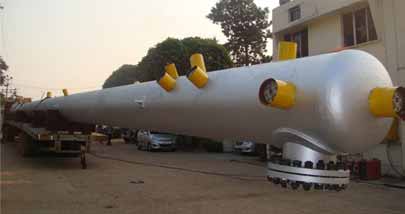In 1911 the “Rules for the Construction of Stationary Boilers and Allowable Working Pressures” was passed. Five years after this publication, the American Society of Mechanical Engineers (ASME) started offering certifications to manufacturers in the pressure equipment industry as a way of showing that their quality control systems comply with pre-defined standards.
The holders of this certification were licensed to manufacture boilers and pressure vessels under the applicable ASME BPVC Section. Currently, 6,800 Certificate Holders are certified and stamped under the ASME BPVC Certification Program.
There are two sets of certification available for boilers and pressure vessels manufacturers – the ‘U’ Stamp and the ‘R’ Stamp.
the National Board of Boiler Inspectors (NBBI) issues the R-Stamp certification authorising a manufacturer to carry out metallic repairs, including alterations of pressure vessels.
While, ASME BPVC Certification Program issues the U-Stamp certificate to an ASME U-Stamp Vessel Manufacturer, authorising it to manufacturer boilers and pressure vessels following rules governing the design, fabrication, assembly, and inspection.
Below is a list of the certificates available in the ASME BPVC Certification program:
SECTION I: This section covers certificates for all kinds of boilers and valves. Examples include S – Power Boilers, A – Assembly of Power Boilers, E – Electric Boilers, M – Miniature Boiler, PP – Pressure Piping, and V – Boiler Pressure Relief Valves. Some manufacturers only produce certain parts of boilers; they too need certification and usually, go for PRT – Part.
SECTION IV: This section covers certificates for all kinds of heating boilers and valves. Examples include H – Heating Boilers/Cast Iron Sectional Heating Boiler, HLW – Lined Potable Water Heaters, and HV – Heating Boiler Safety Valves. Some manufacturers have the task of producing certain parts of a heating boiler and valve, the certification authorising them is PRT – Parts.
SECTION VIII: This section, which applies to most manufacturers covers pressure vessels, relief valves and relief devices, for both miniature and high pressure. There are three divisions (U, U2, & U3) in this section. When applying, be sure you check for the correct code that includes your product.
SECTION X: Some pressure vessels and boilers are made from plastic rather than the common steel. Fibres are usually used as well. Manufacturers in this line, apply for certification (RP) under this section.
SECTION XII: Transporting gas, petroleum, or even water, requires pressure vessels. Manufacturers and parts producers (PRT) of this particular type of transport apply for certification (T, TV, & TD) under this section.
The above certificates, when issued, have a three years lifespan except for the H (Cast Iron and/or Cast Aluminum) and UM Certificates which are valid for only a year. Review deposits and fees are $11,000. While some certificates cost $1070, others cost $3315, and certification marks cost $335. For certainty, please refer to your application package.
Below is the step by step process to obtaining any of the certifications mentioned above:
1. Obtain Application Forms either directly from ASME office or their authorised agencies.
2. Sign a Service Agreement with an Authorized Inspection Agency (AIA). These third party inspection companies have been accredited by an ASME organisation and their inspectors who hold commission cards are certified by the National Board Inspection Code (NBIC).
3. Submit Application Forms to ASME and Transfer Fees. Different certifications require different fees, consult the application package to ensure you are paying the appropriate fees.
4. Purchase ASME Code Books to help in sorting out the various codes for different purposes.
5. Describe a QC-System according to the ASME code quality control manual and have the procedures prepared.
6. Develop a Demonstration Item, complete with all drawings, calculations, part lists, purchase orders, material test reports, fabrications, inspections, tests, and reporting. All these should be based on ASME code (section VIII) requirements.
7. Verify the qualifications of all staff and personnel involved in the production process.
8. Pre-Joint Review by the Supervisor of AIA – This is done after completing the first seven steps which can take up to four months. An audit is conducted by a supervisor and authorised inspector (designated by the authorised inspection agency – AIA), working under a service agreement with the manufacturer. The auditor’s principal duty is to report non-conformities found in the audit process, giving the operator a chance to correct them at an early stage
9. Finally, there is a Joint Review (Audit) with an ASME Designated person, Authorized Inspector and Authorized Supervisor.
10. Tests after the review must be conducted timely. For example, tests for V, HV, UV, UV3, UD, TV and TD Certificates are held within ninety days from the date of completing the review. Failure to do this means a new review must be done.
11. Issuance of Certificate and Stamp by ASME (only if the audit’s results were satisfactory). And finally, the manufacturer is allowed to stamp its nameplate with the “U” Stamp.
